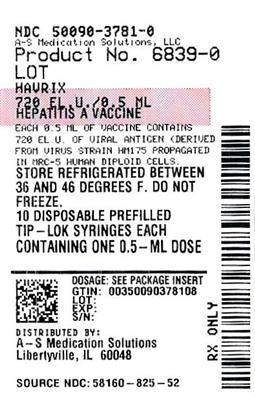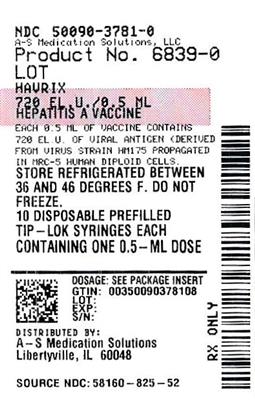14.1 Pediatric Effectiveness Studies
- Protective efficacy with HAVRIX has been demonstrated in a double-blind, randomized controlled study in school children (aged 1 to 16 years) in Thailand who ...
14.1 Pediatric Effectiveness Studies
Protective efficacy with HAVRIX has been demonstrated in a double-blind, randomized controlled study in school children (aged 1 to 16 years) in Thailand who were at high risk of HAV infection. A total of 40,119 children were randomized to be vaccinated with either HAVRIX 360 EL.U. or ENGERIX-B [Hepatitis B Vaccine (Recombinant)] 10 mcg at 0, 1, and 12 months. Of these, 19,037 children received 2 doses of HAVRIX (0 and 1 months) and 19,120 children received 2 doses of control vaccine, ENGERIX-B (0 and 1 months). A total of 38,157 children entered surveillance at Day 138 and were observed for an additional 8 months. Using the protocol-defined endpoint (≥2 days absence from school, ALT level >45 U/mL, and a positive result in the HAVAB-M test), 32 cases of clinical hepatitis A occurred in the control group. In the group receiving HAVRIX, 2 cases were identified. These 2 cases were mild in terms of both biochemical and clinical indices of hepatitis A disease. Thus the calculated efficacy rate for prevention of clinical hepatitis A was 94% (95% Confidence Interval [CI]: 74, 98).
In outbreak investigations occurring in the trial, 26 clinical cases of hepatitis A (of a total of 34 occurring in the trial) occurred. No cases occurred in vaccinees who received HAVRIX.
Using additional virological and serological analyses post hoc, the efficacy of HAVRIX was confirmed. Up to 3 additional cases of mild clinical illness may have occurred in vaccinees. Using available testing, these illnesses could neither be proven nor disproven to have been caused by HAV. By including these as cases, the calculated efficacy rate for prevention of clinical hepatitis A would be 84% (95% CI: 60, 94).
14.2 Immunogenicity in Children and Adolescents
Immune Response to HAVRIX 720 EL.U./0.5 mL at Age 11 to 25 Months (Study HAV 210)
In this prospective, open-label, multicenter study, 1,084 children were administered study vaccine in 1 of 5 groups:
(1) Children aged 11 to 13 months who received HAVRIX on a 0- and 6-month schedule;
(2) Children aged 15 to 18 months who received HAVRIX on a 0- and 6-month schedule;
(3) Children aged 15 to 18 months who received HAVRIX coadministered with INFANRIX and Haemophilus b (Hib) conjugate vaccine (no longer U.S.-licensed) at Month 0 and HAVRIX at Month 6;
(4) Children aged 15 to 18 months who received INFANRIX coadministered with Hib conjugate vaccine at Month 0 and HAVRIX at Months 1 and 7;
(5) Children aged 23 to 25 months who received HAVRIX on a 0- and 6-month schedule.
Among subjects in all groups, 52% were male; 61% of subjects were White, 9% were Black, 3% were Asian, and 27% were other racial/ethnic groups. The anti-hepatitis A antibody vaccine responses and geometric mean antibody titers (GMTs), calculated on responders for Groups 1, 2, and 5 are presented in Table 2. Vaccine response rates were similar among the 3 age-groups that received HAVRIX. One month after the second dose of HAVRIX, the GMT in each of the younger age-groups (aged 11 to 13 months and 15 to 18 months) was shown to be similar to that achieved in the 23- to 25-month age-group.
In 3 additional clinical studies (HAV 232, HAV 220, and HAV 231), children received either 2 doses of HAVRIX alone or the first dose of HAVRIX concomitantly administered with other routinely recommended U.S.-licensed vaccines followed by a second dose of HAVRIX. After the second dose of HAVRIX, there was no evidence for interference with the anti-HAV response in the children who received concomitantly administered vaccines compared with those who received HAVRIX alone. [See Adverse Reactions (6.1), Clinical Studies (14.5).]
Immune Response to HAVRIX 360 EL.U. among Individuals Aged 2 to 18 Years
In 6 clinical studies, 762 subjects aged 2 to 18 years received 2 doses of HAVRIX (360 EL.U.) given 1 month apart (GMT ranged from 197 to 660 mIU/mL). Ninety-nine percent of subjects seroconverted following 2 doses. When a third dose of HAVRIX 360 EL.U. was administered 6 months following the initial dose, all subjects were seropositive (anti-HAV ≥20 mIU/mL) 1 month following the third dose, with GMTs rising to a range of 3,388 to 4,643 mIU/mL. In 1 study in which children were followed for an additional 6 months, all subjects remained seropositive.
Immune Response to HAVRIX 720 EL.U./0.5 mL among Individuals Aged 2 to 19 Years
In 4 clinical studies, 314 children and adolescents ranging from age 2 to 19 years were immunized with 2 doses of HAVRIX 720 EL.U./0.5 mL given 6 months apart. One month after the first dose, seroconversion (anti-HAV ≥20 mIU/mL [lower limit of antibody measurement by assay]) ranged from 96.8% to 100%, with GMTs of 194 mIU/mL to 305 mIU/mL. In studies in which sera were obtained 2 weeks following the initial dose, seroconversion ranged from 91.6% to 96.1%. One month following the booster dose at Month 6, all subjects were seropositive, with GMTs ranging from 2,495 mIU/mL to 3,644 mIU/mL.
In an additional study in which the booster dose was delayed until 1 year following the initial dose, 95.2% of the subjects were seropositive just prior to administration of the booster dose. One month later, all subjects were seropositive, with a GMT of 2,657 mIU/mL.
14.3 Immunogenicity in Adults
More than 400 healthy adults aged 18 to 50 years in 3 clinical studies were given a single 1440 EL.U. dose of HAVRIX. All subjects were seronegative for hepatitis A antibodies at baseline. Specific humoral antibodies against HAV were elicited in more than 96% of subjects when measured 1 month after vaccination. By Day 15, 80% to 98% of vaccinees had already seroconverted (anti-HAV ≥20 mIU/mL [lower limit of antibody measurement by assay]). GMTs of seroconverters ranged from 264 to 339 mIU/mL at Day 15 and increased to a range of 335 to 637 mIU/mL by 1 month following vaccination.
The GMTs obtained following a single dose of HAVRIX are at least several times higher than that expected following receipt of immune globulin.
In a clinical study using 2.5 to 5 times the standard dose of immune globulin (standard dose = 0.02 to 0.06 mL/kg), the GMT in recipients was 146 mIU/mL at 5 days post-administration, 77 mIU/mL at Month 1, and 63 mIU/mL at Month 2.
In 2 clinical trials in which a booster dose of 1440 EL.U. was given 6 months following the initial dose, 100% of vaccinees (n = 269) were seropositive 1 month after the booster dose, with GMTs ranging from 3,318 mIU/mL to 5,925 mIU/mL. The titers obtained from this additional dose approximate those observed several years after natural infection.
In a subset of vaccinees (n = 89), a single dose of HAVRIX 1440 EL.U. elicited specific anti-HAV neutralizing antibodies in more than 94% of vaccinees when measured 1 month after vaccination. These neutralizing antibodies persisted until Month 6. One hundred percent of vaccinees had neutralizing antibodies when measured 1 month after a booster dose given at Month 6.
Immunogenicity of HAVRIX was studied in subjects with chronic liver disease of various etiologies. One hundred eighty-nine healthy adults and 220 adults with either chronic hepatitis B (n = 46), chronic hepatitis C (n = 104), or moderate chronic liver disease of other etiology (n = 70) were vaccinated with HAVRIX 1440 EL.U. on a 0- and 6-month schedule. The last group consisted of alcoholic cirrhosis (n = 17), autoimmune hepatitis (n = 10), chronic hepatitis/cryptogenic cirrhosis (n = 9), hemochromatosis (n = 2), primary biliary cirrhosis (n = 15), primary sclerosing cholangitis (n = 4), and unspecified (n = 13). At each time point, GMTs were lower for subjects with chronic liver disease than for healthy subjects. At Month 7, the GMTs ranged from 478 mIU/mL (chronic hepatitis C) to 1,245 mIU/mL (healthy). One month after the first dose, seroconversion rates in adults with chronic liver disease were lower than in healthy adults. However, 1 month after the booster dose at Month 6, seroconversion rates were similar in all groups; rates ranged from 94.7% to 98.1%. The relevance of these data to the duration of protection afforded by HAVRIX is unknown.
In subjects with chronic liver disease, local injection site reactions with HAVRIX were similar among all 4 groups, and no serious adverse reactions attributed to the vaccine were reported in subjects with chronic liver disease.
14.4 Duration of Immunity
The duration of immunity following a complete schedule of immunization with HAVRIX has not been established.
14.5 Immune Response to Concomitantly Administered Vaccines
In 3 clinical studies HAVRIX was administered concomitantly with other routinely recommended U.S.-licensed vaccines: Study HAV 232: Diphtheria and tetanus toxoids and acellular pertussis vaccine adsorbed (INFANRIX, DTaP) and Haemophilus b (Hib) conjugate vaccine (tetanus toxoid conjugate) (manufactured by Sanofi Pasteur SA); Study HAV 220: Pneumococcal 7-valent conjugate vaccine (PCV-7) (manufactured by Pfizer), and Study HAV 231: MMR and varicella vaccines. [See Adverse Reactions (6.1).]
Concomitant Administration with DTaP and Hib Conjugate Vaccine (Study HAV 232)
In this U.S. multicenter study, 468 subjects, children aged 15 months were randomized to receive: Group 1) HAVRIX coadministered with INFANRIX and Hib conjugate vaccine (n = 127); Group 2) INFANRIX and Hib conjugate vaccine alone followed by a first dose of HAVRIX 1 month later (n = 132); or Group 3) HAVRIX alone (n = 135). All subjects received a second dose of HAVRIX alone 6 to 9 months following the first dose. Among subjects in all groups combined, 53% were male; 64% of subjects were White, 12% were Black, 6% were Hispanic, and 18% were other racial/ethnic groups.
There was no evidence for reduced antibody response to diphtheria and tetanus toxoids (percentage of subjects with antibody levels ≥0.1 mIU/mL to each antigen), pertussis antigens (percentage of subjects with seroresponse, antibody concentrations ≥5 EL.U./mL in seronegative subjects or post-vaccination antibody concentration ≥2 times the pre-vaccination antibody concentration in seropositive subjects, and GMTs), or Hib (percentage of subjects with antibody levels ≥1 mcg/mL to polyribosyl-ribitol phosphate, PRP) when HAVRIX was administered concomitantly with INFANRIX and Hib conjugate vaccine (Group 1) relative to INFANRIX and Hib conjugate vaccine administered together (Group 2).
Concomitant Administration with Pneumococcal 7-Valent Conjugate Vaccine (Study HAV 220)
In this U.S. multicenter study, 433 children aged 15 months were randomized to receive: Group 1) HAVRIX coadministered with PCV-7 vaccine (n = 137); Group 2) HAVRIX administered alone (n = 147); or Group 3) PCV-7 vaccine administered alone (n = 149) followed by a first dose of HAVRIX 1 month later. All subjects received a second dose of HAVRIX 6 to 9 months after the first dose. Among subjects in all groups combined, 53% were female; 61% of subjects were White, 16% were Hispanic, 15% were Black, and 8% were other racial/ethnic groups.
There was no evidence for reduced antibody response to PCV-7 (GMC to each serotype) when HAVRIX was administered concomitantly with PCV-7 vaccine (Group 1) relative to PCV-7 administered alone (Group 3).
Concomitant Administration with MMR and Varicella Vaccines (Study HAV 231)
In a U.S. multicenter study, there was no evidence for interference in the immune response to MMR and varicella vaccines (the percentage of subjects with pre-specified seroconversion/seroresponse levels) administered to subjects aged 15 months concomitantly with HAVRIX relative to the response when MMR and varicella vaccines are administered without HAVRIX. [See Adverse Reactions (6.1).]
Close


